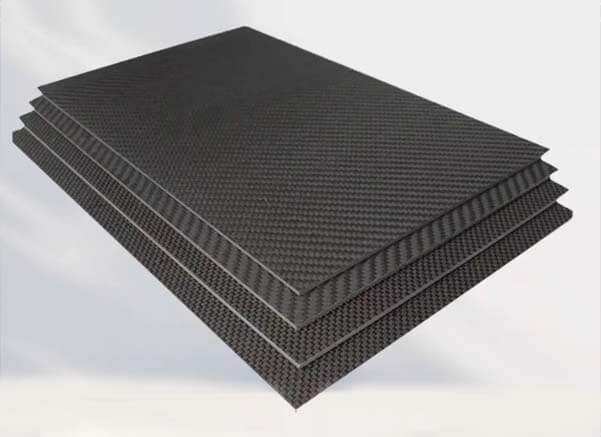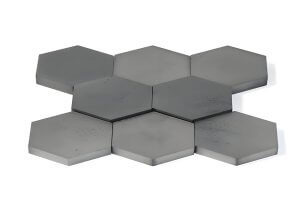Introduction
When it comes to lightweight and high-strength materials, carbon fiber sheets are among the top choices for industries like aerospace, automotive, and electronics. Their unique properties, such as rigidity, corrosion resistance, and low weight, make them ideal for applications where performance and efficiency are critical. However, successfully working with carbon fiber sheets requires precision, and this is where CNC machining plays a pivotal role. In particular, CNC allows for custom machining of carbon fiber sheets, enabling tailored designs and precise specifications to meet unique industry demands.
In this article, I’ll explore the applications of carbon fiber sheets, the best CNC machining techniques, and a detailed cost analysis to help you make informed decisions. Whether you’re an engineer, a machinist, or just curious about advanced materials, this guide will provide practical insights.
Industry Applications of Carbon Fiber Sheets with CNC
2.1 Aerospace Industry
The aerospace industry prioritizes lightweight materials to improve efficiency and performance. Carbon fiber sheets are highly valued for their excellent strength-to-weight ratio, resistance to environmental factors, and ability to meet strict safety standards. CNC machining allows manufacturers to precisely shape carbon fiber sheets into components essential for aerospace applications.
Applications
- UAV (Unmanned Aerial Vehicles):
Drone frames and internal structures use carbon fiber sheets to reduce weight while maintaining rigidity.
CNC-machined parts enable efficient assembly and consistent performance. - Fuselage Panels:
Carbon fiber sheets replace traditional metal panels, reducing overall weight by up to 30%.
CNC cutting ensures panels fit tightly, minimizing drag and improving aerodynamics. - Internal Supports and Brackets:
CNC machining produces high-precision supports for avionics, optimizing space and strength.
Case Study
An aerospace firm implemented CNC-machined carbon fiber sheets in a satellite project, replacing aluminum panels with a carbon fiber alternative. The result was a 25% reduction in launch weight, enabling the company to save millions in launch costs due to lower payload mass.
2.2 Automotive Industry
In the automotive sector, carbon fiber sheets are synonymous with high performance. They are integral to achieving weight reduction, increasing speed, and enhancing fuel efficiency. CNC machining ensures that these sheets can be shaped into aerodynamic and durable components.
Applications
- Racing Cars:
Components such as spoilers, chassis panels, and dashboards rely on carbon fiber sheets for their lightweight and durable properties.
CNC machining is critical for achieving the complex shapes and precise dimensions needed for racing. - Luxury Vehicles:
High-end cars incorporate CNC-machined carbon fiber sheets in trim, seat backs, and decorative panels to combine aesthetics with functionality. - Electric Vehicles (EVs):
Reducing weight is crucial for EV efficiency, and CNC-machined carbon fiber sheets play a significant role in designing lightweight battery enclosures.
| Component | Benefit |
|---|---|
| Chassis | Weight reduction improves handling and speed. |
| Spoilers and Diffusers | Enhances aerodynamics and reduces drag. |
| Battery Enclosures (EVs) | Provides thermal insulation and structural integrity. |
2.3 Sports Equipment
The sports industry heavily relies on carbon fiber sheets for their unparalleled strength and low weight. CNC machining ensures uniformity and precision, which is essential for competitive sports.
Applications
- Bicycles:
Frames made from carbon fiber sheets offer cyclists lightweight durability.
CNC machining produces precise joints and cuts, reducing assembly errors. - Tennis Rackets and Ski Equipment:
CNC machining shapes carbon fiber sheets into cores for skis or rackets, enhancing strength without adding weight.
Example:
A leading sports equipment manufacturer reduced production time by 30% by implementing CNC machining for carbon fiber sheets, while also ensuring consistent product quality.
2.4 Consumer Electronics
In the electronics industry, carbon fiber sheets are favored for their modern appearance and durability. CNC machining allows manufacturers to craft intricate designs required for compact and aesthetically pleasing electronic devices.
Applications
- Phone Cases:
Lightweight and impact-resistant carbon fiber sheets protect devices while adding a sleek design. - Laptop Housings:
CNC machining provides precise cutouts for ports and ventilation, ensuring a perfect fit and professional finish. - Drones:
Frames and arms made from carbon fiber sheets ensure durability without compromising flight performance.
2.5 Medical Devices
Carbon fiber sheets have become a preferred material in the medical field due to their strength, light weight, and biocompatibility. CNC machining ensures these parts meet the stringent standards required for medical-grade components.
Applications
- Prosthetics:
CNC-machined carbon fiber sheets form the lightweight frames of prosthetic limbs, making them more comfortable for users. - Surgical Instruments:
Tools made from carbon fiber sheets are durable and easy to sterilize. - Medical Imaging Equipment:
Carbon fiber sheets are used in X-ray tables and CT scanner components due to their radiolucent properties.
| Application | Key Benefit |
|---|---|
| Prosthetics | Lightweight and user-friendly designs. |
| Imaging Equipment | Radiolucency ensures clear imaging. |
| Surgical Instruments | Strong and resistant to wear. |
2.6 DIY and Prototyping
DIY enthusiasts and small-scale startups often use carbon fiber sheets for custom projects. CNC machining provides an affordable way to precisely cut and shape these sheets into prototypes or small-scale production runs.
Examples
- RC Vehicles:
Frames and parts for remote-controlled cars and planes. - Custom Accessories:
Wallets, phone stands, and other lifestyle products made from carbon fiber sheets.
Why CNC?
- Flexibility: CNC allows for the creation of unique designs.
- Accessibility: Affordable desktop CNC machines can handle carbon fiber sheets with the right tools.
Summary Table: Industry Applications
| Industry | Common Applications | Key Benefits |
|---|---|---|
| Aerospace | Drone frames, fuselage panels | Lightweight, high strength, precision cutting |
| Automotive | Chassis, spoilers, EV battery covers | Reduced weight, improved performance |
| Sports Equipment | Bicycles, rackets, skis | Durability, low weight, consistent quality |
| Consumer Electronics | Phone cases, laptops, drones | Modern design, impact resistance |
| Medical Devices | Prosthetics, imaging equipment | Biocompatibility, radiolucency |
| DIY/Prototyping | RC vehicles, custom products | Customization, affordability |
Why CNC Machining is the Best Choice for Carbon Fiber Sheets
CNC machining stands out as the most efficient and reliable method for processing carbon fiber sheets, offering unmatched precision, repeatability, and cost efficiency. In this section, we’ll dive into the key reasons why CNC machining is the go-to choice for industries working with carbon fiber sheets.
3.1 Precision and Accuracy
Carbon fiber sheets are often used in applications requiring tight tolerances and complex geometries. CNC machines excel at achieving:
- Tight Tolerances: CNC machining ensures precision within microns, critical for aerospace and medical devices.
- Repeatability: Whether it’s one prototype or a batch of components, CNC delivers consistent quality.
Example:
In a drone manufacturing project, CNC machining was used to cut carbon fiber sheets for the frame. With a tolerance of ±0.02 mm, the components fit perfectly, eliminating the need for additional adjustments.
3.2 Efficiency and Scalability
For both small-batch and mass production, CNC machining is highly efficient. It minimizes material waste, optimizes cutting paths, and reduces production time.
Scalability Benefits:
- Prototyping: CNC machines allow for rapid prototyping of carbon fiber sheets, enabling faster design iterations.
- Mass Production: Automated CNC systems can produce hundreds or thousands of identical parts with minimal supervision.
3.3 Compatibility with Complex Designs
Many industries require intricate designs for their products. CNC machines can handle:
- Complex Geometries: Advanced 5-axis CNC machines can process carbon fiber sheets into highly detailed shapes.
- Customization: CNC allows for unique patterns and designs, especially in consumer electronics and sports equipment.
3.4 Waste Reduction
Carbon fiber sheets are expensive, and material waste can significantly impact costs. CNC machining minimizes waste through:
- Optimized Cutting Paths: CAD/CAM software calculates the most efficient cutting routes.
- Nesting Techniques: Multiple parts are strategically positioned on a single sheet to maximize material usage.
| Process | Waste Level | Benefit |
|---|---|---|
| Manual Cutting | High | Risk of material waste and inaccuracies. |
| CNC Machining | Low | Precise cuts reduce scrap material. |
3.5 Versatility Across Applications
CNC machining is adaptable to the diverse needs of carbon fiber sheet processing:
- Thin Sheets: Ideal for lightweight components in aerospace and electronics.
- Thick Sheets: Suitable for structural parts in automotive and industrial applications.
3.6 Tooling and Material Adaptability
Carbon fiber sheets are highly abrasive, posing challenges for traditional cutting methods. CNC machines can use:
- Diamond-Coated Tools: Withstand the abrasive nature of carbon fiber, ensuring durability.
- Carbide Tools: Cost-effective for less demanding applications.
| Tool Type | Best For | Durability |
|---|---|---|
| Diamond-Coated | High-precision and abrasive materials | Excellent |
| Carbide | General-purpose cutting | Moderate |
3.7 Advantages Over Other Cutting Methods
| Cutting Method | Advantages | Limitations |
|---|---|---|
| CNC Machining | High precision, repeatability, and waste reduction | Higher initial equipment cost |
| Waterjet Cutting | No thermal damage, suitable for thick sheets | Higher operating costs, slower for thin materials |
| Laser Cutting | Ideal for intricate designs | Risk of thermal damage to carbon fibers |
| Manual Cutting | Low setup cost | Inconsistent quality and high material waste |
3.8 CNC in My Experience
In one of my projects, CNC machining was the key to producing high-performance bicycle frames from carbon fiber sheets. Traditional methods caused significant material waste and inconsistent results. By switching to CNC machining, we reduced waste by 25% and improved part uniformity, which was crucial for maintaining the structural integrity of the frames.
CNC Machining Techniques for Carbon Fiber Sheets
To maximize the potential of carbon fiber sheets, understanding the best CNC machining techniques is essential. In this section, we’ll explore milling, drilling, waterjet cutting, and laser cutting for carbon fiber sheets.
4.1 CNC Milling
CNC milling is the most versatile and widely used method for processing carbon fiber sheets.
Best Practices:
- Spindle Speed: 10,000–20,000 RPM for clean cuts.
- Feed Rate: Moderate feed rates to prevent delamination.
- Tooling: Use diamond-coated or carbide tools to handle the abrasive nature of carbon fiber.
Applications:
- Cutting intricate patterns for aerospace panels.
- Shaping components for racing cars.
| Parameter | Recommended Range |
|---|---|
| Spindle Speed | 10,000–20,000 RPM |
| Feed Rate | 0.01–0.05 mm/rev |
| Depth of Cut | 0.1–1 mm |
4.2 CNC Drilling
Drilling carbon fiber sheets can be challenging due to the risk of fraying or delamination.
Key Techniques:
- Tooling: Use diamond-coated drill bits for clean holes.
- Coolant: Water-based coolant prevents overheating and reduces dust.
Applications:
- Precision holes for fasteners in automotive and aerospace components.
- Clean openings for electronic devices.
4.3 Abrasive Waterjet Cutting
Waterjet cutting is a non-contact method that uses high-pressure water mixed with abrasives to cut carbon fiber sheets.
Advantages:
- No thermal damage.
- Ideal for thick sheets and large-scale production.
Applications:
- Cutting structural components for EVs and industrial machinery.
4.4 Laser Cutting
Laser cutting offers high precision but requires careful control to avoid thermal damage.
Advantages:
- Perfect for intricate and small-scale designs.
- Fast processing for thin sheets.
Challenges:
- Risk of fiber burnout at the edges.
Summary Table: CNC Techniques
| Technique | Best For | Challenges |
|---|---|---|
| Milling | Versatile, intricate designs | Risk of delamination |
| Drilling | Precision holes | Fraying and tool wear |
| Waterjet Cutting | Thick sheets, non-contact processing | High operating costs |
| Laser Cutting | Intricate designs, fast processing | Thermal damage to edges |
Challenges in Machining Carbon Fiber Sheets and How to Overcome Them
Despite their many advantages, carbon fiber sheets present unique challenges during machining. Their abrasive nature, layered structure, and dust generation require careful handling to ensure successful processing. In this section, we’ll discuss common issues encountered in machining carbon fiber sheets and provide practical solutions.
5.1 Delamination and Fiber Fraying
The Issue:
Delamination occurs when the layers of a carbon fiber sheet separate during machining, while fiber fraying results in uneven or jagged edges. These issues can compromise the structural integrity and aesthetics of the final product.
Causes:
- Excessive tool pressure or speed.
- Dull or improper tooling.
- Insufficient support for the material during machining.
Solutions:
- Optimize Feed and Speed:
Reduce feed rates and match spindle speeds to the material thickness.
Example: For a 2mm carbon fiber sheet, use a feed rate of 0.02 mm/rev and a spindle speed of 15,000 RPM. - Use Proper Tooling:
Diamond-coated or carbide tools provide cleaner cuts and reduce delamination risks. - Secure the Material:
Use vacuum tables or clamping systems to ensure the sheet doesn’t shift during machining.
5.2 Tool Wear
The Issue:
Carbon fiber sheets are highly abrasive due to their composite structure, leading to rapid tool wear.
Causes:
- Continuous contact with the hard fibers in the sheet.
- Using tools not designed for carbon fiber.
Solutions:
- Choose Durable Tools:
Diamond-coated tools are ideal for handling the abrasive nature of carbon fiber. - Monitor Tool Life:
Regularly inspect tools and replace them as needed to avoid compromising quality. - Use Coolant:
A water-based coolant can reduce heat buildup, prolonging tool life.
| Tool Type | Durability | Cost |
|---|---|---|
| Diamond-Coated | High | $$$ |
| Carbide | Moderate | $$ |
5.3 Dust and Health Hazards
The Issue:
Machining carbon fiber sheets generates fine, abrasive dust that can harm machinery and pose health risks if inhaled.
Causes:
- Lack of proper dust extraction systems.
- Insufficient personal protective equipment (PPE).
Solutions:
- Install Dust Extraction Systems:
Use high-efficiency systems to capture dust at the source. - Adopt Wet Machining:
Waterjet cutting or using coolant in CNC machining reduces airborne dust. - Provide PPE:
Operators should wear respirators and safety goggles to prevent inhalation and eye irritation.
Tip: Regularly clean CNC equipment to prevent dust buildup, which can affect machine accuracy and lifespan.
5.4 Thermal Damage
The Issue:
Excessive heat generated during machining can cause thermal degradation of the resin matrix in carbon fiber sheets, leading to weakened material.
Causes:
- High spindle speeds or prolonged tool contact.
- Lack of proper cooling mechanisms.
Solutions:
- Control Machining Parameters:
Reduce spindle speeds and optimize toolpaths to minimize heat buildup. - Use Coolants:
Water-based coolants dissipate heat and maintain material integrity. - Intermittent Machining:
Pausing between passes allows the material to cool down naturally.
| Machining Parameter | Recommended Range |
|---|---|
| Spindle Speed | 10,000–15,000 RPM |
| Feed Rate | 0.01–0.05 mm/rev |
| Coolant Flow Rate | 5–15 liters/min |
5.5 Inconsistent Surface Finish
The Issue:
Rough or uneven surfaces can result from improper tooling or incorrect machining parameters.
Causes:
- Dull tools or excessive tool wear.
- Incorrect depth of cut or feed rate.
Solutions:
- Sharpen or Replace Tools:
Ensure tools are sharp and suited for carbon fiber. - Optimize Depth of Cut:
For thin sheets, a shallow depth of cut (0.1–0.2 mm) is recommended. - Use Finishing Passes:
After rough cutting, a finishing pass with lower feed rates can improve surface quality.
Summary Table: Challenges and Solutions
| Challenge | Cause | Solution |
|---|---|---|
| Delamination and Fraying | Excessive pressure, dull tools | Use sharp tools, optimize feed and speed |
| Tool Wear | Abrasive nature of carbon fibers | Use diamond-coated tools, monitor tool life |
| Dust and Health Hazards | Fine dust generated during machining | Install dust extraction, use PPE |
| Thermal Damage | Excessive heat during machining | Use coolants, intermittent machining |
| Inconsistent Surface Finish | Dull tools, incorrect parameters | Sharpen tools, optimize depth of cut |
Cost Analysis of CNC Machining Carbon Fiber Sheets
Machining carbon fiber sheets can be cost-effective with the right planning and techniques. This section will analyze the costs associated with materials, tooling, and labor.
6.1 Material Costs
The price of carbon fiber sheets depends on thickness, grade, and surface finish.
| Thickness (mm) | Grade | Cost per Square Foot |
|---|---|---|
| 1 mm | Standard | $20–$30 |
| 2 mm | High Strength | $40–$60 |
| 5 mm | Aerospace-Grade | $100–$150 |
6.2 CNC Machining Costs
| Cost Component | Range | Notes |
|---|---|---|
| Setup Costs | $100–$200 per job | Includes programming and calibration. |
| Tooling Costs | $50–$300 per tool | Diamond-coated tools are pricier but last longer. |
| Machining Time | $50–$100/hour | Depends on complexity and batch size. |
6.3 Prototyping vs. Mass Production
| Production Type | Cost Efficiency | Best Practices |
|---|---|---|
| Prototyping | Higher cost per unit | Use small sheets to minimize waste. |
| Mass Production | Lower cost per unit | Optimize toolpaths and use batch setups. |
Innovations and Future Trends in CNC Machining for Carbon Fiber Sheets
The manufacturing landscape is rapidly evolving, and carbon fiber sheets are at the forefront of innovative applications. As CNC machining continues to improve, new technologies and sustainable practices are shaping the future of this field. In this section, we’ll explore the latest advancements and trends that are revolutionizing how carbon fiber sheets are processed and utilized.
7.1 Advanced Materials for Carbon Fiber Sheets
Hybrid Carbon Fiber Composites
- What They Are: Blends of carbon fiber with other materials, such as aramid or fiberglass, to create sheets with enhanced flexibility or impact resistance.
- Applications: Aerospace, automotive crash structures, and high-performance sports equipment.
High-Temperature Carbon Fiber Sheets
- Features: Improved thermal stability and resistance to degradation at elevated temperatures.
- Applications: Aerospace engine components and EV battery enclosures.
| Material Type | Advantages | Applications |
|---|---|---|
| Hybrid Carbon Fiber Composites | Increased flexibility, impact resistance | Sports equipment, automotive crash panels |
| High-Temperature Carbon Fiber Sheets | Thermal stability, durability | Aerospace engines, EV battery casings |
7.2 AI-Driven CNC Systems
What’s New:
Artificial intelligence (AI) is transforming CNC machining by enabling real-time parameter optimization and predictive maintenance.
Key Benefits:
- Adaptive Machining:
AI analyzes tool wear and adjusts parameters like feed rate and spindle speed to maintain precision. - Enhanced Quality Control:
Integrated sensors detect anomalies during machining, reducing defects.
Example:
An aerospace manufacturer used an AI-driven CNC system to machine carbon fiber sheets. The system adjusted cutting speeds dynamically, reducing tool wear by 20% and improving part quality.
7.3 Sustainable Practices
Recycling Carbon Fiber Sheets
- Carbon fiber waste is challenging to recycle, but new technologies are making it possible to recover fibers without compromising strength.
- Recycled carbon fiber sheets are increasingly used in non-structural applications like interior panels and decorative elements.
Efficient Material Utilization
- CNC machines with advanced nesting algorithms minimize waste by optimizing the placement of parts on the sheet.
7.4 5-Axis CNC Machining for Complex Designs
Why It’s Important:
5-axis CNC machines enable the creation of intricate geometries and angled cuts that were previously impossible with traditional methods.
Applications:
- Aerospace: Turbine blades and complex fuselage components.
- Sports: Curved bicycle frames and ergonomic designs.
7.5 My Take on Future Trends
Having worked on projects where efficiency was critical, I see AI-driven systems and advanced materials as game changers for carbon fiber sheet machining. In one case, incorporating nesting software reduced waste by 15%, significantly lowering costs without sacrificing quality.
Conclusion
Carbon fiber sheets are a game-changer for industries ranging from aerospace to sports equipment, and CNC machining unlocks their full potential. By understanding the applications, techniques, and challenges associated with machining carbon fiber sheets, manufacturers can achieve precise, efficient, and cost-effective results.
As technology advances, innovations like AI-driven systems and sustainable practices will continue to enhance the machining of carbon fiber sheets, ensuring their place as a cornerstone material for modern manufacturing.
FAQ
8.1 Material and Application Questions
- What makes carbon fiber sheets ideal for CNC machining?
Their strength, rigidity, and compatibility with precision cutting make them a perfect match for CNC processes. - How do carbon fiber sheets compare to aluminum or steel?
Carbon fiber sheets are lighter and stronger but more expensive than these metals. - Can carbon fiber sheets handle high temperatures?
Yes, high-temperature variants are available for aerospace and automotive applications.
8.2 CNC Techniques
- What are the best tools for CNC machining carbon fiber sheets?
Diamond-coated or carbide tools are recommended for their durability and precision. - How can I prevent delamination when machining carbon fiber sheets?
Optimize feed rates and use sharp tools designed for composites. - Is laser cutting or CNC milling better for carbon fiber sheets?
CNC milling is better for thicker sheets, while laser cutting excels at intricate designs. - What parameters should I use for drilling carbon fiber sheets?
Use a spindle speed of 10,000–20,000 RPM and a slow feed rate to avoid fraying.
8.3 Cost and Maintenance
- How much does CNC machining carbon fiber sheets cost?
Costs vary but typically range from $50–$100/hour for machining, plus material costs. - How do I extend the life of tools when machining carbon fiber sheets?
Use coolant, reduce feed rates, and replace tools regularly. - What’s the most economical way to produce custom designs with carbon fiber sheets?
Optimize nesting layouts and use CNC machines for precise cuts to minimize waste.
8.4 Challenges and Safety
- How do I manage the dust generated during CNC machining?
Use high-efficiency dust extraction systems and wear protective equipment. - What are the health risks of machining carbon fiber sheets, and how can they be mitigated?
Inhalation of fine dust can irritate the lungs. Use respirators and ensure proper ventilation.
8.5 Innovations
- What are the latest advancements in machining carbon fiber sheets?
AI-driven CNC systems, hybrid composites, and advanced tooling. - Are there sustainable options for recycling carbon fiber sheets?
Yes, new recycling methods recover fibers for reuse in non-structural applications. - How does 5-axis CNC machining improve processing of carbon fiber sheets?
It allows for more complex geometries and reduces the need for secondary operations.
Other Articles You Might Enjoy
- Carbon Fiber Phone Case Uncovered: From Material Science to Cutting-Edge Machining
Why Carbon Fiber for Phone Cases? When you hear about a carbon fiber phone case, what’s your first thought? For many, it’s the image of a sleek, lightweight, and durable…
- Decoding Carbon Fiber Strain in Advanced Machining Applications
Introduction: The Unique Properties and Applications of Carbon Fiber I’ve always been fascinated by how materials behave under stress. Carbon fiber, in particular, has this almost legendary status in aerospace,…
- Innovative CNC Machining for Advanced Wearable Technology
Innovative CNC Machining for Advanced Wearable Technology The advent of Computer Numerical Control (CNC) machining and wearable technology has transformed various industries, including healthcare, fitness, fashion, and defense. CNC machining…
- Maximizing Precision in CNC Machining: Techniques and Tips
Importance of Precision in CNC Machining Precision is an fundamental component in the field of Computer Numerical Control (CNC) machining. It entails producing parts that are not only accurate but…
- Optimizing CNC Machining Parts Using Constant Surface Speed Techniques
CNC machining, particularly on lathes, can be a complex process, but understanding and utilizing constant surface speed (CSS) techniques can simplify and enhance the efficiency of your operations. The key…
- Material Versatility in CNC Machining: From Titanium to Thermoplastics
Introduction to CNC Machining CNC machining stands as a cornerstone in the manufacturing sector, enabling the precise creation of parts and components. This process utilizes computer numerical control (CNC) to…
- Mastering Measurement Techniques for CNC Machining Parts
Measurement tools are the unsung heroes in the world of CNC machining. They ensure that every part produced meets the necessary specifications and standards. Understanding these tools and their applications…
- Machining Techniques for Parts: Unlocking CNC and Cutting-Edge Tech
I. Introduction I remember the first time I realized how critical machining is to modern manufacturing. I was interning at a small shop, watching a CNC machine carve intricate features…






